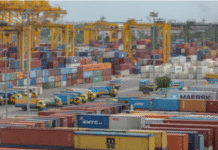The projection is also lower than the government’s revised target of 6.5%, Bangladesh Bank’s revised projection of around 6%
Asian Development Bank has further cut its growth forecast for Bangladesh due to slowed down exports and remittances, and political unrest before national election in early January this year.
In its Asian Development Outlook 2014 released yesterday simultaneously throughout the Asia region, it said GDP is projected to grow by 5.6%, which is lower than its earlier projection of 5.8% for fiscal year (2013-14) ending in June.
The projection is also lower than the government’s revised target of 6.5%, Bangladesh Bank’s revised projection of around 6%, the World Bank’s 5.7% and International Monetary Fund’s 6% and Bloomberg’s 6.3%.
“GDP of Bangladesh is expected to slow,” said Oleg Tonkonojenkov, ADB deputy country director for Bangladesh while releasing the outlook in Dhaka.
It reflected apprehended slower expansion in exports, falling worker remittances, and political unrest before parliamentary elections affecting consumer and investors confidence, he said.
However, he expected the GDP growth to improve in FY15, but a major boost will come only with higher investment in infrastructure. Lauding positive achievements in some areas, Tonkonojenkov said Bangladesh performed well in terms of economic and social developments over the past several decades.
“Macroeconomic management has been sound, and economic growth was largely inclusive and broad-based, with notable progress in poverty reduction. Bangladesh is on track to achieve most of the millennium development goals,” he said. He said Bangladesh needs to pay much more attention to boosting its infrastructure skills, if the country has to move to a higher growth path.
Major reforms in tax policies and strengthening tax administration will be a priority to gear up public resource mobilisation, he said. In addition to mobilising resources, public sector capacity for implementing projects will need to be significantly strengthened.
“As has been the case with other rapidly growing developing countries, the private sector will also need to be engaged in financing infrastructure projects under public private partnerships (PPP).”
In response to a question, ADB’s Principal Country Economist Mohammad Zahid Hossain said Bangladesh has great prospects to grow at more than 7%, but needs investment in a bigger way, developing infrastructure and restoring political stability.
In his presentation on economic prospects for Bangladesh, he said growth is expected to rebound to 6.2% in FY2015, aided by higher remittance and export growth, as well as by prospects for continued economic recovery in the US and the euro area.
A likely rise in consumer and investors confidence as the political situation stabilises is also expected to stimulate demand and strengthen growth momentum. Industry growth expected to slow to 8% in FY14 because of the output lost to political unrest in the first half of the year, and as weaker domestic demand depresses production.
Production by the RMG may also be affected if foreign buyers postpone orders in response to delays in implanting agreed fire and building safety standards to prevent further industrial accidents.
Industry growth is expected to grow to 9% in FY2015 with a pickup in domestic and external demand, better safety standards and compliance in garment factories and gains in power generation.
Agriculture is projected to rebound to 3% in FY2014, aided by favorable weather conditions in the early months of the year and reflecting the previous year’s low base.
Inflation is expected to rise to an average of 7.5% in this fiscal year because of the effects of supply disruptions, rising wages in both the public and the private sector, and expected increases in electricity and fuel prices.
Source: Dhaka Tribune










